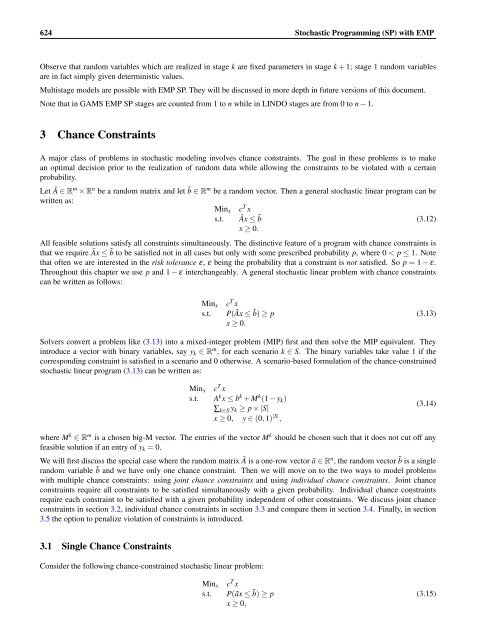Stochastic Programming (SP) with EMP - Gams
Stochastic Programming (SP) with EMP - Gams
Stochastic Programming (SP) with EMP - Gams
Create successful ePaper yourself
Turn your PDF publications into a flip-book with our unique Google optimized e-Paper software.
624 <strong>Stochastic</strong> <strong>Programming</strong> (<strong>SP</strong>) <strong>with</strong> <strong>EMP</strong><br />
Observe that random variables which are realized in stage k are fixed parameters in stage k + 1; stage 1 random variables<br />
are in fact simply given deterministic values.<br />
Multistage models are possible <strong>with</strong> <strong>EMP</strong> <strong>SP</strong>. They will be discussed in more depth in future versions of this document.<br />
Note that in GAMS <strong>EMP</strong> <strong>SP</strong> stages are counted from 1 to n while in LINDO stages are from 0 to n − 1.<br />
3 Chance Constraints<br />
A major class of problems in stochastic modeling involves chance constraints. The goal in these problems is to make<br />
an optimal decision prior to the realization of random data while allowing the constraints to be violated <strong>with</strong> a certain<br />
probability.<br />
Let à ∈ Rm × Rn be a random matrix and let ˜b ∈ Rm be a random vector. Then a general stochastic linear program can be<br />
written as:<br />
Minx cT s.t.<br />
x<br />
Ãx ≤ ˜b<br />
x ≥ 0.<br />
(3.12)<br />
All feasible solutions satisfy all constraints simultaneously. The distinctive feature of a program <strong>with</strong> chance constraints is<br />
that we require Ãx ≤ ˜b to be satisfied not in all cases but only <strong>with</strong> some prescribed probability p, where 0 < p ≤ 1. Note<br />
that often we are interested in the risk tolerance ε, ε being the probability that a constraint is not satisfied. So p = 1 − ε.<br />
Throughout this chapter we use p and 1 − ε interchangeably. A general stochastic linear problem <strong>with</strong> chance constraints<br />
can be written as follows:<br />
Minx c T x<br />
s.t. P(Ãx ≤ ˜b) ≥ p<br />
x ≥ 0.<br />
Solvers convert a problem like (3.13) into a mixed-integer problem (MIP) first and then solve the MIP equivalent. They<br />
introduce a vector <strong>with</strong> binary variables, say yk ∈ R m , for each scenario k ∈ S. The binary variables take value 1 if the<br />
corresponding constraint is satisfied in a scenario and 0 otherwise. A scenario-based formulation of the chance-constrained<br />
stochastic linear program (3.13) can be written as:<br />
Minx c T x<br />
s.t. A k x ≤ b k + M k (1 − yk)<br />
∑k∈S yk ≥ p × |S|<br />
x ≥ 0, y ∈ (0,1) |S| ,<br />
where M k ∈ R m is a chosen big-M vector. The entries of the vector M k should be chosen such that it does not cut off any<br />
feasible solution if an entry of yk = 0.<br />
We will first discuss the special case where the random matrix à is a one-row vector ã ∈ R n , the random vector ˜b is a single<br />
random variable ˜b and we have only one chance constraint. Then we will move on to the two ways to model problems<br />
<strong>with</strong> multiple chance constraints: using joint chance constraints and using individual chance constraints. Joint chance<br />
constraints require all constraints to be satisfied simultaneously <strong>with</strong> a given probability. Individual chance constraints<br />
require each constraint to be satisfied <strong>with</strong> a given probability independent of other constraints. We discuss joint chance<br />
constraints in section 3.2, individual chance constraints in section 3.3 and compare them in section 3.4. Finally, in section<br />
3.5 the option to penalize violation of constraints is introduced.<br />
3.1 Single Chance Constraints<br />
Consider the following chance-constrained stochastic linear problem:<br />
Minx c T x<br />
s.t. P(ãx ≤ ˜b) ≥ p<br />
x ≥ 0,<br />
(3.13)<br />
(3.14)<br />
(3.15)

















